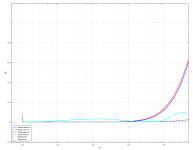If you need better overall response for 96kHz filter, I suggest using my 3rd order coefficients instead of Orban's/Wurcer's 4th order (2x biquad) coefficients (error plot attached). My 3rd order MZT/MIM based coefficients are:
Coefficients based on Orban's poles/zeros:
are:
Wurcer's 4th order (2 x biquad) implementation can be found from his article.
Code:
b = [0.112505293158829 -0.033756941867625 -0.066435946167708 -0.006063956599930];
a = [1.000000000000000 -1.378665728551891 -0.044341939523520 0.423638954754309];Coefficients based on Orban's poles/zeros:
Code:
z = [-0.4510059, -0.1619979, -0.2531282E-01, 0.9678047];
p = [-0.3815793, -0.8907574E-01, 0.8703285, 0.9967329];are:
Code:
1.000000000000000e+00 6.130038000000005e-01 7.306200868761005e-02 1.000000000000000e+00 4.706550399999999e-01 3.398945851618199e-02
1.000000000000000e+00 -9.424918799999991e-01 -2.449786616625399e-02 1.000000000000000e+00 -1.867061400000001e+00 8.674850497576508e-01Wurcer's 4th order (2 x biquad) implementation can be found from his article.
Attachments
Wow that's neat, thanks for sharing this! Will definately give these coefficients a try. It'll take some time until I get my setup back together though. But it's something to look forward to 🙂If you need better overall response for 96kHz filter, I suggest using my 3rd order coefficients instead of Orban's/Wurcer's 4th order (2x biquad) coefficients (error plot attached). My 3rd order MZT/MIM based coefficients are:
Code:b = [0.112505293158829 -0.033756941867625 -0.066435946167708 -0.006063956599930]; a = [1.000000000000000 -1.378665728551891 -0.044341939523520 0.423638954754309];
Coefficients based on Orban's poles/zeros:
Code:z = [-0.4510059, -0.1619979, -0.2531282E-01, 0.9678047]; p = [-0.3815793, -0.8907574E-01, 0.8703285, 0.9967329];
are:
Code:1.000000000000000e+00 6.130038000000005e-01 7.306200868761005e-02 1.000000000000000e+00 4.706550399999999e-01 3.398945851618199e-02 1.000000000000000e+00 -9.424918799999991e-01 -2.449786616625399e-02 1.000000000000000e+00 -1.867061400000001e+00 8.674850497576508e-01
Wurcer's 4th order (2 x biquad) implementation can be found from his article.
If you need better overall response for 96kHz filter, I suggest using my 3rd order coefficients instead of Orban's/Wurcer's 4th order (2x biquad) coefficients (error plot attached). My 3rd order MZT/MIM based coefficients are:
Code:b = [0.112505293158829 -0.033756941867625 -0.066435946167708 -0.006063956599930]; a = [1.000000000000000 -1.378665728551891 -0.044341939523520 0.423638954754309];
Coefficients based on Orban's poles/zeros:
Code:z = [-0.4510059, -0.1619979, -0.2531282E-01, 0.9678047]; p = [-0.3815793, -0.8907574E-01, 0.8703285, 0.9967329];
are:
Code:1.000000000000000e+00 6.130038000000005e-01 7.306200868761005e-02 1.000000000000000e+00 4.706550399999999e-01 3.398945851618199e-02 1.000000000000000e+00 -9.424918799999991e-01 -2.449786616625399e-02 1.000000000000000e+00 -1.867061400000001e+00 8.674850497576508e-01
Wurcer's 4th order (2 x biquad) implementation can be found from his article.
I used old (from ~2005) zero-pole data for Orban's 4th order filter coefficients. Here are newer (from 2007) but 3rd order data taken from his comp.dsp post back in 2007:
poles and zeros
Code:
z = [-0.3096394, -0.4513594e-01, 0.9677730];
p = [-0.1992839, 0.8703280, 0.9967002];which results to a 3rd order filter coefficients:
Code:
b = 1.141249286497031e-01 -6.995831420993498e-02 -3.758888605595347e-02 -1.543592747073277e-03
a = 1.000000000000000 -1.667744300000000 0.495387430559620 0.172870033025878Second order sections are then:
Code:
1.000000000000000 0.354775340000000 0.013975865380036 1.000000000000000 -0.671044099999998 -0.173442358119200
1.000000000000000 -0.967773000000000 0 1.000000000000000 -0.996700200000003 0Attached error plot shows similarity between Orban's and Wurcer's calculation methods.

